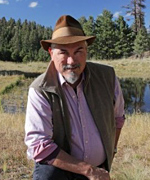—Alan Dulaney

Back in June 2013, this column described two property owners in Cochise County who objected to a decision by ADWR to issue a Designation of Water Adequacy to Pueblo del Sol Water Company to include a 7,000 home subdivision called Tribute. They claimed that the proposed pumping of 4,870 AF of groundwater would essentially dry up major reaches of the San Pedro River, reducing their property values; thus, surface water flows had to be considered. The administrative law judge ruled that ADWR lacked authority to consider impacts to the river when considering physical, legal, and continuous availability of groundwater for 100 years. The Designation was issued in June 2013. The landowners, including Robin Silver, a founder of the Southwestern Center for Biodiversity and an experienced litigant, filed a lawsuit in Superior Court to appeal the Designation decision.
And then things got interesting. The BLM, which manages the San Pedro Riparian National Conservation Area, joined in the lawsuit, asserting superior Federal rights to sufficient water to maintain perennial flows in the San Pedro River — even though such rights have not been adjudicated. They argued that ADWR incorrectly issued the Designation because the criterion of legal availability had not been adequately evaluated since SPRNCA surface water rights (even though those rights have not yet been confirmed and quantified by adjudication) had been ignored.
That’s a Very Big Deal, because it strikes at the heart of Arizona’s bifurcated groundwater and surface water legal structure. Count the implications. If claimed Federal rights trump State water law, then who is really in control of water in Arizona? The Feds have always deferred to State law in water matters; would they recognize continued Arizona’s predominance or undermine it through continued lawsuits to establish their own priority? If surface water rights must be maintained (prior appropriations) in administering the law, then how can any groundwater permits be issued by ADWR? Almost any groundwater use could be shown to impact a surface water right somewhere. If surface water rights must be considered, then should not ADWR rewrite the entire rule structure for the Adequate Water Supply program — and, since they share the same set of rules, the Assured Water Supply program? What about the effects of recharge? What about well impact rules and the issuance of drilling authorities? What does this do the entire structure of ADWR programs and permitting? If surface water rights aren’t quantified because the State has spent 35+ years on the process, shouldn’t Arizona hurry up and get the adjudications done? Like, yesterday?
I didn’t think BLM and the other plaintiffs stood a chance in Superior Court — but I was dead wrong. ADWR lost. The Superior Court judge agreed with the plaintiffs and ruled that ADWR’s decision to issue the Designation of Adequate Water Supply was in error. Now ADWR is appealing, and I suspect they will go all the way to the Supreme Court. That ruling could rock the foundations of Arizona water law. Meanwhile, the designation of Adequate Water Supply remains in effect.
All eyes on Cochise County, folks, where whiskey is for drinking and water is still for fighting.